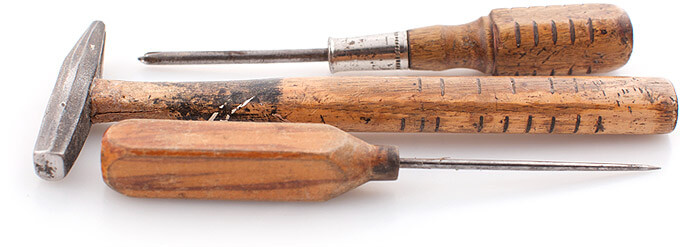
Pianos are very complicated instruments. Properly restoring one requires a broad range of expertise. At Lindeblad Piano Restoration, we have assembled a team of craftsmen unrivaled in our industry. At every step of the restoration your piano is carefully attended to by a craftsman with the unique ability to bring out the best in your precious instrument. The Piano Restoration 101 video series provides a detailed introduction to this fascinating process.


Bridges distribute the downward pressure of the strings, transferring the strings' sound to the soundboard. Soundboards magnify the vibrational response of piano hammers striking the strings. Soundboards are made from tonal woods; Alaskan Sitka Spruce is the choice for leading piano makers. A diaphragmatic design – where the soundboard tapers several millimeters from the crown to the edge of the inner rim – and an exact fit inside the cabinet's rim are the recipe for resonance and projection.

Carefully drilled with more than 200 holes, the pinblock's job is to tightly grip the tuning pins. Just like a nail suspending a picture on a wall loses its hold over time, the same is true with tuning pins. To ensure the tuning pins don't budge, pinblocks are made of 5 to 7 layers of kilned hard rock maple, and fastened onto the resting plank at a 7-degree angle.

Accounting for half of a piano's weight, the cast-iron harp combines immense weight with an elegant aesthetic designed to bear 20,000 lbs. of string tension. Aside from the cabinet, the harp is the only other part of a vintage piano that is always reused in restoration. Restored harps are re-bronzed to add an attractive brilliance under a piano's lid.

The most recognizable feature under a piano's lid is the strings. Over 200 strings are kept in A440 pitch by German made Diamond tuning pins, which are anchored into the pinblock. All of our strings are made from the finest Swedish steel. The bass range strings are coiled with copper. Brass agraffes guide the strings to the tuning pins. Agraffes need to be replaced because they wear with time and are susceptible to breaking. We use the same strings, agraffes, and tuning pins as Steinway.

Often referred to as the "keybed" or "action stack," the action transfers the momentum of a musician's keystrokes to the strings. Actions give the desired volume, tonal effect, and repetition to each note. The action is comprised of wippens, shanks, hammers, and flanges. Aside from leathers, felts, and hardware, actions are largely constructed from hornbeam wood. Hornbeam is air-dried for several years to eliminate the possibility of warping. Actions require precise assembly and regulation to deliver a pure flawless sound.

Grand pianos have over 10,000 moving parts. Many careful calibrations to these parts keep pianos playing beautifully. A single key's performance requires over 12 adjustments. Fine alterations must be made to the key height, key weight, let-off, drop, and back-check. Additionally, each hammer is voiced to match a musician's desired brilliance and resonance. Restoring a piano to its fullest potential requires a highly trained ear, an exact feel, and an intuition that only comes with generations of experience.

Dampers dictate the stopping or sustain of the strings' vibrations. Arranged in a uniform row behind the agraffes, damper heads add a wooden accent on top of our Swedish steel strings. The damper felts rest on top of the strings until a key is pressed. The far right sustain pedal raises all dampers to add substance and expand dynamic possibilities. Due to their high frequency, the higher octave strings do not require dampers.

Most pianos today have three pedals. The far right sustain pedal broadens dynamic possibilities by raising all dampers, thus suspending all notes. The middle sostenuto pedal creates a similar effect by only raising the dampers of the notes played while being pressed.The far left una corda pedal changes tone color by shifting the entire keybed action to the right. Each hammer then only strikes two strings instead of three, softening the overall sound. When used sensitively, pedals allow musicians to achieve new levels of musicality.

The distinctive arrangement of 36 sharps and 52 "ivories" are the crowning symbol of any piano. Pianos haven't always had 88 keys. Steinways from the late 1800s usually have 85 keys. Some concert grands today have nearly 100 keys! Keys are typically constructed from spruce and are carefully regulated with conical lead weights for the perfect response to touch. Ivory keytops reveal beautiful grain patterning when polished. Due to ivory bans, today's keys are made with an acrylic that resembles ivory in color and feel.

The cabinet houses all internal components of a piano, and enables the vibrations of the soundboard to resonate richly. Cabinets are constructed from a number of woods: African Mahogany, Hard Rock Maple, and Walnut are popular choices. A cabinet's color is the most noticeable feature of a piano. Each cabinet is hand-rubbed with a colored stain to bring out the patterning of the wood's grain. Polish (satin or high gloss) and texture (open pore or closed pore) also add a unique dimension to each piano's finish.

